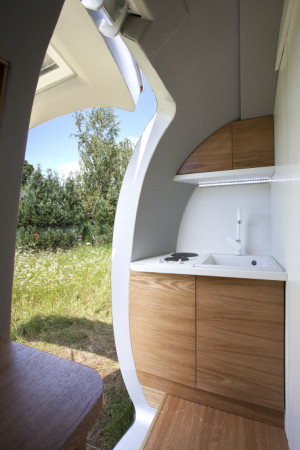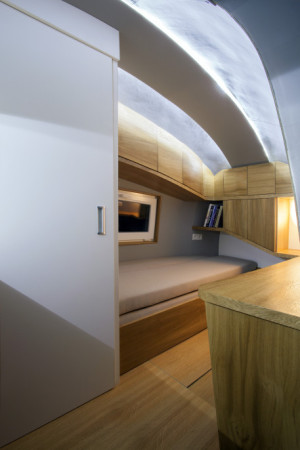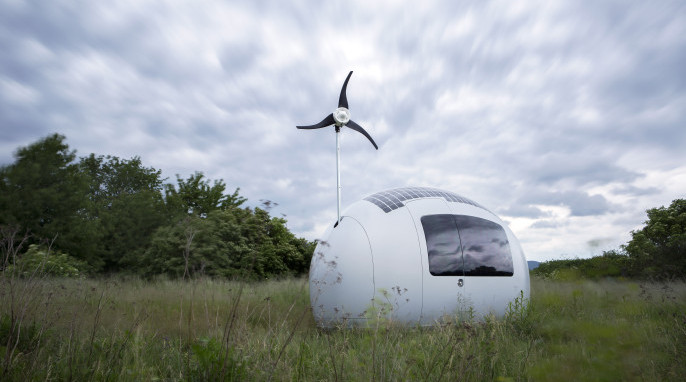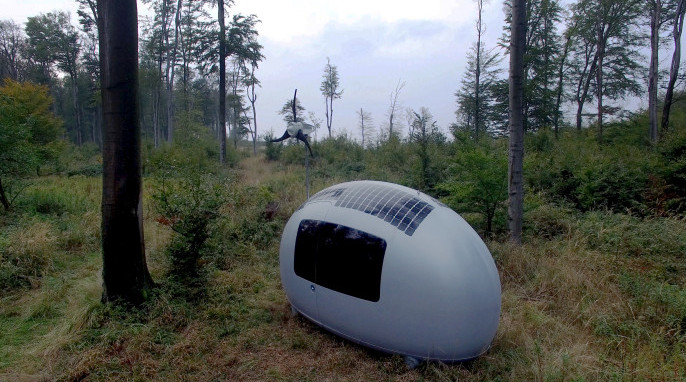Egg-Shaped Tiny House to Revolutionize Off-Grid Living
If you spot Nice Architects’ Ecocapsule while hiking through the woods or turning the corner from your campsite, you may think you’ve come upon an alien spacecraft or advanced military technology. Deep blue solar cells pattern its sleek surface, glistening in the sun. A curving wind turbine stretches toward the sky. This lustrous, egg-shaped capsule is no military secret, but could be a revolutionary solution to self-sufficient housing powered by renewable energy.


A Tiny Friend of the Earth
Surprise is usually the first reaction to the Ecocapsule’s egg-like curvature. The pod is 4.45 meters long, 2.25 meters wide, and 2.55 meters high, just tall enough to allow an average-sized person to stand comfortably. This small size and unique shape have been chosen to reduce energy consumption and improve reliance on off-grid, renewable energy.
“The most important function of the shape in terms of energy independence is surface reduction, thus thermal losses reduction,” says Nice Architects partner and architect Igor Zacek. “However, the shape is also helping to reduce aerodynamic drag; therefore it can sustain windy conditions.”
The walls of any house leak thermal energy, so minimizing their surface area while creating enough interior space is a primary architectural challenge to conserve energy use from heating. Mathematics tells us that a sphere should work well: It is the three-dimensional object with the smallest surface area to volume ratio. This shape might not offer the most comfortable living environment, however, so Nice Architects elongated the shape in one direction, providing enough space to include a bed, bathroom, composting toilet, kitchenette, desk, and cabinets.
RELATED: OFF-GRID TINY HOUSE WILL BLOW YOUR MIND
This combination of sleek architecture and practical engineering helps the Ecocapsule gather its energy from only local and renewable resources. The egg-like shape guides falling rainwater into water tanks below the floor, where reverse osmosis filters clean the water for drinking and cooking. Whereas a square roof would trap water and require additional equipment like gutters for transport, the curving surface of the house provides both an aesthetic and practical method for moving water to the tanks.
Solar panels and a wind turbine on the roof also provide a combined 1.35 kilowatts (kW) of average power. Energy captured from these sources power LED lighting as well as floor and water heating. Energy not immediately used is stored in a 10-kilowatt-hour (kWh) battery, which can provide enough energy for four days when the sun stops shining or the wind vanishes. This storage capacity helps the Ecocapsule continue to harness renewable energy in a variety of places.
RELATED: STARTUP FOUNDERS NEED JOINERS FOR SUCCESS
“It is [an] off-grid system and it can only harness energy available in the environment. Therefore, [the] ideal region is mild climate with plenty of sun and wind,” says Zacek. “On the other hand, Ecocapsule can cope with conditions in central Europe, where you have very hot summers and harsh winters with plenty of snow.”
The Ecocapsule can be connected to an electrical grid if necessary, but Nice Architects’ design makes this unnecessary in most environments. Whereas the average household of two used roughly 1500 kWh per month in 2014, the Ecocapsule design reduces this consumption to 100 kWh per customer, due to gains in energy efficiency and the house’s tiny footprint.


Ecocapsule Tiny House Unveiled
Finding a way to combine all the architectural and engineering requirements for minimal energy consumption was a major obstacle during development. “The first and most difficult part was to put all [the] small pieces of the puzzle together in order to ensure functionality of the unit,” says Zacek. “[The] next biggest challenge after we managed to squeeze everything together in the small body of the unit was [the] building of the unit itself. Since it is a very complex project requiring many different professions to be employed during the project, it was hard to find [a] factory/workshop capable of doing it under one roof.”
Despite these difficulties, Nice Architects found a way to consolidate production, and now the Ecocapsule is ready for its first international release. Fifty units selling for 79,900 Euros each are now available to consumers in the United States, Canada, the European Union, and Australia. This allows for a small network of distribution and service centers to support new Ecocapsule owners prior to a global release in 2017.
“As we are [a] startup company, we have adopted [the] Tesla way of developing the product,” says Zacek. “Thus, we plan to use all revenues generated by limited production to develop and prepare mass production, which will bear very competitive prices.”
The Future of Eco-Friendly, Tiny House Living


Nice Architects has already completed several test trials in which volunteers slept in the capsule overnight and discussed their satisfaction with the sleeping arrangements. So far, everyone has reported being well-rested and comfortable, a good sign for the company that people can adapt to the small space.
With the limited release under way, the architects and engineers are already planning new features for the Ecocapsule. Engineers plan to replace the current composting toilet with an incineration design in future models. In addition, Zacek hopes to integrate a smart home system so that appliances and heating can be controlled with a tablet or smartphone. The solar cells and batteries are also being improved to take advantage of the latest technology, with higher efficiency and storage capacity.
The promise of the Ecocapsule pushes the boundaries of how we might live with the smallest footprint possible in this crowded world. Its applications seem endless: housing at remote research stations, long-term camping, or a truly 21st century cabin in the woods. The true tests of its flexibility will likely come when campers try to live off the grid in the cloudy Pacific Northwest or strain the heating systems in Antarctic research stations. Only then will we know if intermittent power generated by only a solar cell and small wind turbine will be enough. If the capsule does become popular, Zacek hopes its unique design and minimalist interior could inspire furniture or future power systems specifically designed for the tiny house.
Fifty people, meanwhile, will have the chance to experience a completely different style of living, discovering how little energy we need from the sun and wind to live a sustainable life in harmony with the earth.


References
Information about Ecocapsule provided by Nice Architects
OFF-GRID TINY HOUSE WILL BLOW YOUR MIND
Ecocapsule photos courtesy of Tomas Manina, Juraj Fifik, and Martin Barabas




